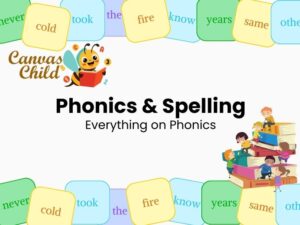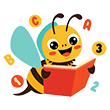Phonics & Spelling
The key to Phonics & Spelling, a foundational literacy skill, is understanding how letters (graphemes) and their sounds (phonemes) match. Students learn letter-sound relationships through phonics practice in the classroom and online using a variety of activities and instruction to successfully decode (read) and encode (type) words.
Phonics & Spelling errors are common in English because it’s a challenging language. On the other hand, children who receive clear instruction in the phonics code and spelling logic have a strong foundation in spelling.
Everything on Phonics
| Vowels | are letters (graphemes) that are not consonants |
| Diphthongs | are sounds formed by combining two vowels in a single syllable |
| Digraphs | are formed when two letters come together to create one sound |
| Consonant Blends | are a set of two or three consonant letters that when pronounced, retain their sound |
| Syllables | are phonological building blocks of words |
Patterns of Phonics
Due to the increasingly complex phonetic patterns, phonics practice exercises in the classroom and online are still beneficial far into middle school, despite phonics’ significant influence in the primary grades. Pupils with strong phonological awareness abilities are better able to decode and encode more complex words by applying their knowledge of letters and sounds to comprehend words and their patterns.
Through consistent phonics and spelling pattern instruction, students acquire the skills necessary to read and spell words. Kids can play entertaining and captivating online phonics practice games to assist improve their retention of these concepts.
Vowels
Vowels are letters (graphemes) that are not consonants. Vowel sounds, or phonemes, are produced when the lips and throat are not closed in any manner. Although vowels are represented by five letters, there are really twenty vowel sounds in total—12 of which are pure vowel sounds—when diphthongs are taken into consideration. The short vowels are one type of vowel sound. The “a” in “cat” and other short vowel sounds sound nothing like their letter designations. Pronouncing long vowels identically to their letter names differentiates them from other classes of vowel sounds. The silent “e” at the end of a word is one pattern of vowels that results in a long vowel. For instance, because the word “tale” has a silent “e,” the “a” sounds like the letter name for that word.
Below are other short and long vowel patterns and phonics word lists.
Vowel Patterns Phonetic Word Lists |
|
|---|---|
| Vowel Pattern | Word Examples |
| Short “a” | fan, pan, man, mat, cat, rat |
| Short “e” | pen, ten, when, bet, let, jet |
| Short “i” | bit, pit, fit, fin, win, pin |
| Short “o” | pot, lot, dot, hop, shop, drop |
| Short “u” | fun, run, sun, bun, up, cup |
| Long “a” | fail, rain, pail, tale, whale, male |
| Long “e” | feet, sheep, keep, heat, meat, beat |
| Long “i” | cried, pie, flies, file, mile, pile |
| Long “o” | boat, coat, float, bone, cone, note |
| Long “u” | blue, clue, true, cute, cube, tube |
Diphthongs
When two vowels are combined into one phoneme to make a single syllable, the result is a diphthong, also called a gliding vowel. One vowel sound starts the sound and progresses to another.
The most common diphthong spelling patterns in the English language are:
Diphthongs Lists |
|
|---|---|
| Diphthong | Word Examples |
| “oy”/ “oi” | boy, toy, joy, coin, joint, noise |
| “ow”/ “ou” | howl, plow, now, cloud, round, mouse |
Digraphs
A digraphs is a pair of letters that together make a single phoneme. Digraphs fall into two categories: vowel digraphs and consonant digraphs. A combined set of consonants, such as “sh” in “shark,” make a single sound in a consonant digraph. Initial consonant digraphs and ending consonant digraphs are the two places where consonants can occur in a word. Two vowels combined to produce a single sound, like “ay” in “away,” are called vowel digraphs. Vowel digraphs can occur in a word’s beginning, middle, or end. Digraphs are a fundamental concept that may be learned through online phonics practice using our kid-friendly word collections and activities that are grade level appropriate.
The following table features other consonant and vowel digraphs:
Digraphs Lists |
||
|---|---|---|
| Digraph | Consonant Digraph or Vowel Digraph | Word Examples |
| “ch” | Consonant Digraph | chose, chair, ouch, much |
| “sh” | Consonant Digraph | shout, she, wash, rash |
| “th” | Consonant Digraph | thing, thank, teeth, math |
| “ay” | Vowel Digraph | say, stay, play, pay |
| “ea” | Vowel Digraph | each, cheat, wheat, neat |
| “oa” | Vowel Digraph | oat, float, goat, cloak |
Consonant Blends
A group of two or three consonant letters that maintain their sound when spoken together are called consonant blends. Initial blends, or beginning blends of a word, and final blends, or ending blends, are two instances of consonant blends, commonly referred to as consonant clusters. “br” in the word “break” is an illustration of an initial consonant blend. “St” in the word “list” is an illustration of a final consonant blend.
Other initial and final consonant blends include:
Consonant Blends Lists |
||
|---|---|---|
| Blend | Initial or Final Consonant Blend | Word Examples |
| “bl-” | Initial Blend | blend, blind, blue |
| “cl-” | Initial Blend | climb, cloud, clue |
| “dr-” | Initial Blend | drama, drink, drive |
| “pl-” | Initial Blend | place, plan, play |
| “sm-” | Initial Blend | small, smell, smile |
| “-ct” | Final Blend | act, fact, project |
| “-lp” | Final Blend | gulp, help, scalp |
| “-mp” | Final Blend | camp, jump, stamp |
| “-nd” | Final Blend | and, band, land |
| “-rk” | Final Blend | bark, dark, park |
Syllables
Vowels, or sounds resembling them, are included in every syllable, which are discrete units of speech. An unmarked syllable is one that terminates with a vowel. Similar to the initial syllable of the word “paper” (pa-per), an open syllable produces a long vowel sound. A syllable is considered closed if it terminates in a consonant. As in the first syllable of the word “idol” (i-dol), closed syllables have a short vowel sound.
Open and Closed Syllables Lists |
|
|---|---|
| Open First Syllable | apron (a-pron); bacon (ba-con); pilot (pi-lot); detail (de-tail) |
| Closed First Syllable | seven (sev-en); doctor (doc-tor); locket (lock-et); thunder (thun-der) |
Words can have multiple syllables or just one syllable, which is known as monosyllabic words. Trisyllabic words consist of three syllables, whereas disyllabic words include two syllables. The following list of words includes trisyllabic, disyllabic, and monosyllabic words.
Monosyllabic, Disyllabic, and Trisyllabic Lists |
|
|---|---|
| Monosyllabic Words | cat; sun; act; bus; red; few; moon; week |
| Disyllabic Words | issue (is-sue); party (par-ty); tiger (ti-ger); women (wo-men); police (po-lice) |
| Trisyllabic Words | magical (ma-gi-cal); energy (e-ner-gy); visitor (vi-si-tor); popular (po-pu-lar) |


